Drinking Water Protection
- Drinking Water Protection Home
- About Us
- A-Z Index of Contaminants in Water
- Community Public Water Supply
- Drinking Water Grants and Loans
- Drinking Water Institute
- Drinking Water in Schools and Child Cares
- Drinking Water Revolving Fund
- Laws and Rules
- Noncommunity Public Water Supply
- Source Water Protection
- Water Operator and Certification Training
- Drinking Water Protection Contacts
Related Topics
- Annual Reports
- Drinking Water Risk Communication Toolkit
- Drinking Water Protection External Resources
- Fact Sheets
- Forms
- Invisible Heroes Videos: Minnesota's Drinking Water Providers
- Noncom Notes Newsletter
- Sample Collection Procedures (videos, pictures, written instructions)
- Waterline Newsletter
Related Sites
- 10 States Standards
- Clean Water Fund
- Health Risk Assessment – Guidance Values and Standards for Water
- Minnesota Well Index
- Water and Health
- Wells and Borings
Environmental Health Division
Joint Powers Water Board Brings Aquifer Storage Technology to Minnesota
From the Spring 2009 Waterline
Quarterly Newsletter of the Minnesota Department of Health Public Water Supply Unit, Waterline
A complete list of feature stories can be found on the Waterline webpage.
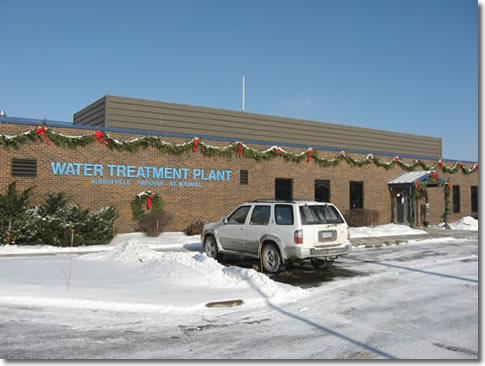 |
More than 30 years ago several communities 25 to 30 miles to the northwest of the Twin Cities, straddling the line between Hennepin and Wright Counties, began working together to provide drinking water to their residents. In 1977, they formed a utility, the Joint Powers Water Board (JPWB) of Albertville, Hanover, St. Michael, and Frankfort (the latter a township that has since been absorbed by St. Michael).
In 2000, the Joint Powers Water Board completed a water treatment plant with three horizontal pressure filters to remove iron and manganese. Within a few years two more filters were added to meet the demand caused by growth in the population. The expansion brought the plant to a capacity of 10 million gallons per day, but continued population growth caused the board to look at the possibility of adding more wells.
 |
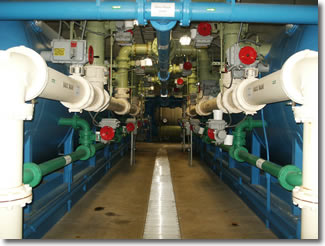 |
| The horizontal pressure filters at the water treatment plant in Albertville. | |
Kelly Daleiden, the project manager for Veolia Water North American Central, which operates the plant on a contract basis for JPWB, said that any new wells would have to be in the southern portion of the service area, in the vicinity of St. Michael and Hanover, and wouldn’t be feasible for the existing plant, which is in Albertville. As a result, a new treatment plant would be needed, not just another expansion of the current plant.
Working first with Chris Catlin and then with Chris Larson at the St. Paul engineering firm of Howard R. Green Company, the Joint Powers Board began exploring a different way to meet the growing demand. Instead of constructing another plant, JPWB opted for a technology that has been used in the eastern and southern United States since 1969.
Aquifer Storage and Recovery (ASR) involves injecting water into an aquifer during periods of surplus and/or low demand and then pumping it out when it is needed. “The purpose of ASR is to allow you to peak shave the size of your water treatment plant in that you can treat closer to your average daily demand rather than building the treatment plant capacity to treat the maximum daily demand,” said Larson. “You realize significant capital savings if your treatment plant is sized only to treat the average daily demand.”
JPWB has been getting its water from seven wells that draw from either glacial drift or the Mount Simon aquifer. In 2006, construction began on Well 9, in St. Michael, which would serve as an ASR well, getting its water from the distribution system and injecting it into the aquifer. Completed in 2007, the well is 504 feet deep and goes into the Mount Simon aquifer.
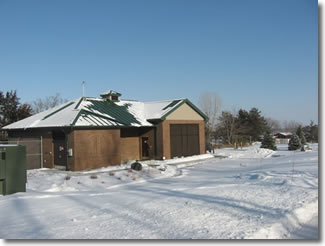 |
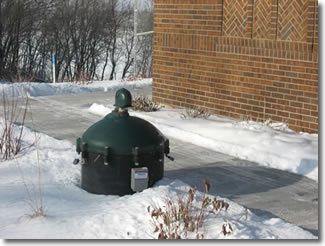 |
| Construction on Wellhouse 9, with the well in front of it, began in 2006 and was completed in 2007. | |
Larson pointed out that the well is a basic production well that has a stainless-steel injection tube, three inches in diameter, which extends through the static water table, allowing the utility to pump water into the aquifer. “It does not mix but rather displaces the water already there,” he explained.
The water being injected into the aquifer will push out the water in such a manner that the water around Well 9 will be treated water taken directly from the distribution system. The Mount Simon is a confined aquifer, with the Eau Claire aquifer as an upper confining unit and Proterozoic volcanic and sedimentary rock as the lower confining unit. Because it is confined, the water displaces horizontally. In the aquifer are a mixing zone and a buffer zone, which allows the system to recover much of the treated water.
“The treated water being pumped back into the aquifer will displace the native water and push the water that contains iron and manganese back,” said Larson. “They will be able to recover the water that is free of iron and manganese.”
The well will recharge the aquifer in the winter and fall, when demand is lower, then recover it in the summer. Although the aquifer has been recharged with treated water, when it is recovered it may need some additional disinfection. Larson said sodium hypochlorite, along with fluoride, will be added as necessary before the water goes into the distribution system.
Another advantage of using ASR is that it reduced concerns about an abandoned landfill that has a groundwater contaminant plume migrating to the area of the new well field. Although the contaminants are in a different aquifer, the potential for contaminant migration exists if the aquifers are hydraulically connected. Since there is net-zero withdrawal from the Mount Simon aquifer, potential migration of the landfill plume into the well field will be mitigated.
JPWB received a variance from the Minnesota Department of Health to use an injection well for a two-phase pilot study, using water from two existing wells. “We will pump a certain amount of water into the aquifer, and then we will recover somewhere around that volume of water,” said Larson. “Part of it is going to mix a bit. The question is what percentage of recovery can we get before something becomes objectionable.”
The first phase of the pilot study will be performed with 300,000 gallons of recharge and 150 percent recovery. The water will be tested as it is pumped out to determine the point at which the water quality changes from treated ASR water to native Well 9 water.
“There are a couple of things we can test to see that: iron and manganese concentrations, oxidation reduction potential,” explained Larson. “The treated water we’re pumping into the aquifer is oxidized, has chlorine in it, and the iron and manganese has been removed. We pump in 300,000 gallons and have to recover 450,000 gallons.”
The second phase of the pilot study will involve five million gallons of recharge with 150 percent recovery. When the ASR system is fully operational, Larson said they will be recharging the aquifer with 60 million gallons of water for later recovery.
Larson said the pilot studies should be complete by the summer of 2009. If all goes well, they will begin recharging for full-scale recovery later in the year. It will be the first application of Aquifer Storage and Recovery in Minnesota.
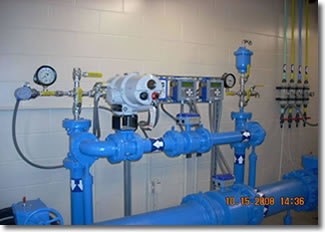 |
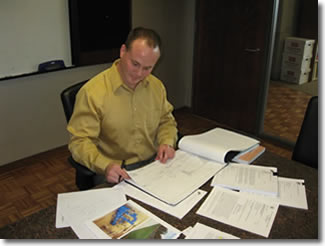 |
| The ASR piping inside Wellhouse 9 (left) is the “only piping needed for ASR,” according to Chris Larson, shown at the right. | |